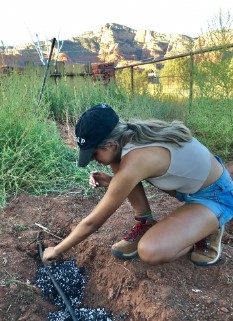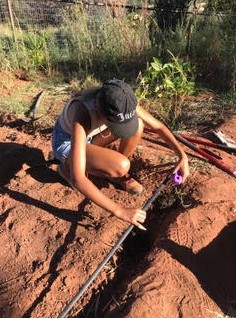Cassie Pataky and Nicole Johnson
Senior Staff & Contributing Writer
On Oct. 12, Visala Tallavarjula, a fourth-year environmental studies major at UC Santa Barbara (UCSB), spoke at the United States Patent and Trademark Office in Virginia about her agricultural technique that reduces the use of freshwater and yields greater plant growth. The project, a culmination of over seven years of research, development, and contest submissions with earlier iterations, is Tallavarjula’s life’s work. In a climate of ever-rising temperatures and populations, fresh water and sustainably harvested crops are both increasingly vital and rare. Tallavarjula’s agricultural method seeks to meet this rising demand, evade expensive irrigation techniques, and expand the accessibility of fresh produce to all. The Bottom Line (TBL) sat down with Tallavarjula to learn more about this project and her game-changing innovation.

Named “Sequestron,” Tallavarjula’s innovation synthesizes three distinct components. The first is a topsoil layer amended with perlite that helps prevent evaporation, conserving up to 30 percent of water. Second, the invention also includes a pipe extension for a drip irrigation system, which directs the water below the topsoil to the root zone, ensuring a more efficient delivery of water to the plants.
“Subsurface irrigation is very expensive,” she noted, “so I wanted to find a way to irrigate below that topsoil bed without using that type of irrigation.”
Third, Tallavarjula’s design consists of a percolation control layer (PCL) of soil modified with charcoal below the root zone, preventing the wasteful downward movement of water beyond the plant roots. Altogether, Sequestron could conserve up to 50 percent of water used in irrigation systems.
Tallavarjula’s inclination and inspiration for water conservation stems from a summer drive through California’s arid Central Valley just prior to her attending high school. A fundamental irony presented itself as she passed billboards expressing concerns for drought, while simultaneously watching the water evaporate from large-scale sprinkler systems before reaching the fields.
“I found [the ‘save water’ signs] really funny, because agriculture clearly was not doing that. So I did some further research and that’s when I discovered subsurface irrigation, which I wanted to mimic and improve upon,” Tallavarjula told TBL.
Though motivated to act on this hypocrisy, Tallavarjula was a high school freshman at the time; her skills could not yet match her ambitions. Her father, Sai Tallavarjula, an engineer, guided her by introducing her to experimental design, statistical analysis, material collection, and other key aspects of her work. This quickly became their long-term project together, winning the young scientist several competition titles throughout her high school career.
Tallavarjula has tested her innovation multiple times in real-world applications, the technique proving effective in conserving water and escalating crop yields to different extents in each context. A COVID-19-era application of Sequestron conducted completely over Zoom in Odisha, India saw a 25 percent increase in okra grown. Though, Tallavarjula notes, this data is skewed due to her physical absence.
Her current project in Sedona, Arizona, where she has been able to actualize Sequestron hands-on, holds more promise. With the help of the Sedona Greenhouse Project, an organization that provides local produce to the Sedona community via regenerative agricultural practices, she is closely monitoring the effects of her innovation.
“It’s really exciting that my project can grow there and provide food for people,” she shared with TBL.

Tallavarjula’s years of research have made her weary of the heavily mechanized, large-scale nature of agriculture, and she thinks Sequestron could be a small step in a big revolution to bring food and water cultivation back to its roots. She observes that people often prefer buying locally produced food from farmer’s markets and co-ops, and in small communities, it is easier to enforce sustainable agricultural techniques that produce better-tasting and improved crops.
“My goal with this project is to have it be implemented in developing regions,” Tallavarjula said, “particularly because a lot of the small farmers there grow a lot of our agriculture, but we tend to forget about them.”
To ensure that her work serves the communities she designed Sequestron for, Tallavarjula strives to maintain control over her invention. Recently, Tallavarjula spoke at the U.S. Patent and Trademark Office as a participant in an intercollegiate competition. Though she did not win, she gained valuable insight into patents and networked with many graduate students and companies. Despite interest in her design from several companies, Tallavarjula is currently applying to accelerators such as Y Combinator, which jump-started companies like DoorDash and AirBnB, in order to patent her project as her own.
For the future, she envisions a tiered company, partially non-profit, that aims to help communities in need for little-to-no cost. She explained that farmers in developing regions are hesitant about outsiders introducing entirely new farming methods. Thus, her technique is designed to be gradually introduced, establishing trust with farmers before implementing the rest of the design.
Growing up, Tallavarjula always wanted to work with water and dreamed of researching marine life and coastal ecosystems. Though she never envisioned herself in agriculture, pursuing her vision felt right, and she is excited to see how it will continue to grow.

















